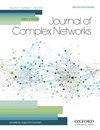利用基于行为的脑结构网络模型研究认知能力
IF 1.5
4区 数学
Q2 MATHEMATICS, INTERDISCIPLINARY APPLICATIONS
引用次数: 0
摘要
网络神经科学的最新发展突出了开发分析和建模大脑网络的技术的重要性。研究复杂神经系统的一种特别强大的方法是建立生成模型,使用布线规则来合成与给定连接体拓扑结构非常相似的网络。成功的模型可以突出网络的组织原则(识别由布线规则产生的结构特征与出现的结构特征),并可能揭示网络增长和发展的机制。先前的研究表明,这种模型可以验证空间嵌入和其他(非空间)布线规则在塑造人类连接体网络拓扑方面的有效性。在这项研究中,我们提出了基于动作的模型的变体,该模型结合了能够解释人类连接体拓扑结构的各种生成因素。我们通过评估模型解释受试者之间可变性的能力来测试模型的描述性有效性。我们的分析提供了证据,证明几何约束对大脑区域之间的连接至关重要,基于拓扑和几何特性的动作模型可以解释结构网络特性的受试者之间的可变性。此外,我们测试了受试者优化模型的参数与认知能力的各种测量之间的相关性,发现较高的认知能力与个体形成长期或非局部联系的倾向有关。本文章由计算机程序翻译,如有差异,请以英文原文为准。
Investigating cognitive ability using action-based models of structural brain networks
Recent developments in network neuroscience have highlighted the importance of developing techniques for analysing and modelling brain networks. A particularly powerful approach for studying complex neural systems is to formulate generative models that use wiring rules to synthesize networks closely resembling the topology of a given connectome. Successful models can highlight the principles by which a network is organized (identify structural features that arise from wiring rules versus those that emerge) and potentially uncover the mechanisms by which it grows and develops. Previous research has shown that such models can validate the effectiveness of spatial embedding and other (non-spatial) wiring rules in shaping the network topology of the human connectome. In this research, we propose variants of the action-based model that combine a variety of generative factors capable of explaining the topology of the human connectome. We test the descriptive validity of our models by evaluating their ability to explain between-subject variability. Our analysis provides evidence that geometric constraints are vital for connectivity between brain regions, and an action-based model relying on both topological and geometric properties can account for between-subject variability in structural network properties. Further, we test correlations between parameters of subject-optimized models and various measures of cognitive ability and find that higher cognitive ability is associated with an individual's tendency to form long-range or non-local connections.
求助全文
通过发布文献求助,成功后即可免费获取论文全文。
去求助
来源期刊

Journal of complex networks
MATHEMATICS, INTERDISCIPLINARY APPLICATIONS-
CiteScore
4.20
自引率
9.50%
发文量
40
期刊介绍:
Journal of Complex Networks publishes original articles and reviews with a significant contribution to the analysis and understanding of complex networks and its applications in diverse fields. Complex networks are loosely defined as networks with nontrivial topology and dynamics, which appear as the skeletons of complex systems in the real-world. The journal covers everything from the basic mathematical, physical and computational principles needed for studying complex networks to their applications leading to predictive models in molecular, biological, ecological, informational, engineering, social, technological and other systems. It includes, but is not limited to, the following topics: - Mathematical and numerical analysis of networks - Network theory and computer sciences - Structural analysis of networks - Dynamics on networks - Physical models on networks - Networks and epidemiology - Social, socio-economic and political networks - Ecological networks - Technological and infrastructural networks - Brain and tissue networks - Biological and molecular networks - Spatial networks - Techno-social networks i.e. online social networks, social networking sites, social media - Other applications of networks - Evolving networks - Multilayer networks - Game theory on networks - Biomedicine related networks - Animal social networks - Climate networks - Cognitive, language and informational network
 求助内容:
求助内容: 应助结果提醒方式:
应助结果提醒方式:


